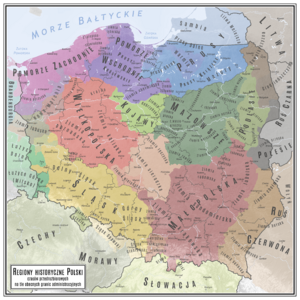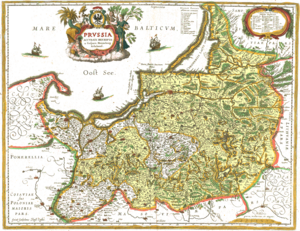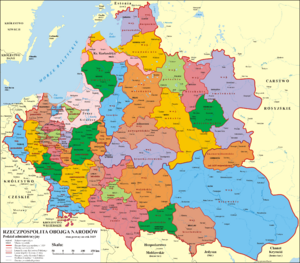Royal Prussia facts for kids
Quick facts for kids Royal Prussia
|
|||||||||
|---|---|---|---|---|---|---|---|---|---|
| Province of Poland | |||||||||
| 1466–1569 | |||||||||
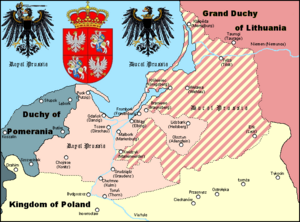 Map of Royal Prussia (light pink) |
|||||||||
| Area | |||||||||
| • Coordinates | 54°N 19°E / 54°N 19°E | ||||||||
| History | |||||||||
|
• Established
|
19 October 1466 | ||||||||
| 1 July 1569 | |||||||||
|
|||||||||
| Today part of | Poland Russia¹ |
||||||||
| ¹ Small portion of the Vistula Spit around Polski | |||||||||
Royal Prussia (also known as Polish Prussia) was a special part of the Crown of the Kingdom of Poland. It became part of Poland in 1466 after a peace treaty called the Second Peace of Thorn (1466). This area included lands from Pomerelia and western Prussia, which used to belong to the State of the Teutonic Order.
Royal Prussia was unique because it had a lot of autonomy. This means it could mostly govern itself. It kept its own laws, customs, and rights. The German language was also widely used there, as many people spoke it.
In 1569, Royal Prussia became fully part of the Kingdom of Poland. Its special self-rule was mostly ended. Its local parliament joined the main Polish parliament, called the Sejm of the Polish–Lithuanian Commonwealth. Much later, in 1772 and 1793, the land that was once Royal Prussia was taken over by the Kingdom of Prussia. This happened during the Partitions of Poland, when Poland's neighbors divided its lands.
Contents
Where was Royal Prussia?
Royal Prussia was located in the northern part of what is now Poland. It included several important areas:
- Pomerelia: This region included the important city of Gdańsk (Danzig) and the mouth of the Vistula River. It also had the Lauenburg and Bütow land.
- Chełmno Land: This area included the city of Toruń (Thorn).
- Western Prussia: This part was given up by the Teutonic Order in 1466. It included:
It's important to know that there was also another part of Prussia called Ducal Prussia. This was the eastern part of Prussia. It remained under the control of the Teutonic Knights for a while. Later, it became a separate duchy ruled by the House of Hohenzollern. Ducal Prussia was a vassal state of Poland, meaning it was loyal to the Polish king but had its own ruler. Royal Prussia, however, was directly part of the Kingdom of Poland.
History of Royal Prussia
The Prussian Confederation
The people living in the lands ruled by the Teutonic Knights were not always happy. They faced high taxes and felt the Knights ruled unfairly. Because of this, citizens in the big Prussian cities started to organize.
In 1397, some nobles formed the Lizard League. After the Teutonic Knights lost the Battle of Grunwald in 1410, their power weakened. Many towns and nobles then swore loyalty to the Polish king. Even though the Knights regained some control, they had to pay a large sum of money to Poland. This made the people's tax burden even heavier.
To protect their rights, nobles and citizens formed a joint group in 1412. Later, in 1440, as taxes kept rising, nobles and cities created the Prussian Confederation. This group was against the Knights' policies. The Confederation was like a local parliament, with two parts representing nobles and citizens. They made decisions together.
The main leaders of the Confederation were from the cities of Danzig (Gdańsk), Elbing (Elbląg), and Thorn (Toruń). In February 1454, the Confederation sent a group to King Casimir IV Jagiellon of Poland. They asked him for help against the Teutonic Order. They also asked for their homeland to become part of the Kingdom of Poland.
After talks, King Casimir IV agreed on March 6, 1454. He signed an "Incorporation Act." This act made the people of Prussia subjects of the Polish king. It also brought Prussia into the Polish kingdom and gave them a lot of self-rule. The Prussian people kept their rights and special benefits. They could make decisions about their own affairs in their local assemblies.
The Thirteen Years' War
When the Prussian Confederation joined Poland in 1454, it started a war. This war is known as the Thirteen Years' War or "War of the Cities." King Casimir IV appointed Jan Bażyński as the first governor of Royal Prussia during the war.
The war lasted for thirteen years. It ended in October 1466 with the Second Peace of Thorn (1466). This treaty made the Teutonic Order give up its control over Pomerelia and the western half of Prussia to the Polish Crown. This is how Royal Prussia officially became part of Poland.
Becoming Part of the Polish Crown
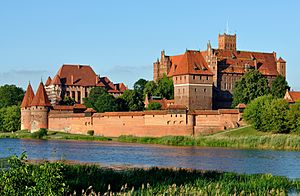
According to the 1454 treaty, Royal Prussia became part of the Crown of the Kingdom of Poland. Its nobles and citizens had the same rights as those in the rest of Poland. Royal Prussia also kept a lot of its self-rule. It kept its own laws, and only Prussians could hold public offices. Decisions about Prussia had to be discussed with the Prussian council.
The Polish way of organizing government was brought into Royal Prussia. It was divided into four main areas called voivodeships. These were Pomeranian, Chełmno, Elbląg (later Malbork), and Królewiec (Königsberg). Each voivodeship was then divided into smaller areas called powiats.
The main governing body of Royal Prussia was the Prussian council. This council included important officials like voivodes and castellan. Later, bishops also joined. This council helped make decisions for the region. Over time, a bicameral (two-part) Prussian parliament developed.
The Bishop of Warmia was a very important figure. At first, he claimed his area was independent. But after a short conflict, Warmia officially became part of Poland in 1479. The Bishop of Warmia then became a member of the Prussian council.
Over time, Royal Prussia became more connected to the rest of the Polish kingdom. In 1506, a new set of laws called the Statute of Prussia was created. It brought many Polish laws into the Prussian legal system. A central treasury was also set up for Prussia.
Full Integration into Poland
In 1569, a very important event happened: the Union of Lublin. This union created the Polish–Lithuanian Commonwealth, a large country formed by Poland and Lithuania. As a result of this union, Royal Prussia became fully integrated into the Crown of the Kingdom of Poland.
This meant that Royal Prussia's special parliament was no longer separate. It became a regular provincial assembly. Other separate Prussian institutions were also ended. The former territory of Royal Prussia was then governed as regular Polish voivodeships: Pomeranian, Chełmno, Malbork, and the Prince-Bishopric of Warmia.
Later Changes
In 1772 and 1793, during the Partitions of Poland, the lands that were once Royal Prussia were taken over by the Kingdom of Prussia. This Kingdom of Prussia was the successor state to the old Teutonic Order.
Governors
Royal Prussia had a few governors before the office was ended:
- 1454–1459: Jan Bażyński, who was a war-time governor.
- 1459–1480: Stibor von Baysen.
- 1480: Niklas von Baysen, who was elected but refused to swear loyalty to the king.
The office of governor was ended in 1510.
See also
- Duchy of Prussia
- Kingdom of Prussia
- Pomerelia
- Kursenieki
- Kashubia
- Warmia
- The plague during the Great Northern War




